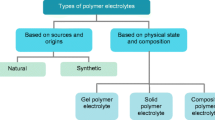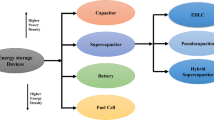Abstract
The hydrophobic conductive polymer, poly(3-octylthiophene) (POT), is considered as uniquely suited to be used as an ion-to-electron transducer in solid contact (SC) ion-selective electrodes (ISEs). However, the reports on the performance characteristics of POT-based SC ISEs are quite conflicting. In this study, the potential sources of the contradicting results on the ambiguous drift and poor potential reproducibility of POT-based ISEs are compiled, and different approaches to minimize the drift and the differences in the standard potentials of POT-based SC ISEs are shown. To set the potential of the POT film, it has been loaded with a 7,7,8,8-tetracyanoquinodimethane (TCNQ/TCNQ·−) redox couple. An approximately 1:1 TCNQ/TCNQ·−ratio in the POT film has been achieved through potentiostatic control of the potential of the redox couple-loaded conductive polymer. It is hypothesized that once the POT film has a stable, highly reproducible redox potential, it will provide similarly stable and reproducible interfacial potentials between the POT film and the electron-conducting substrate and result in SC ISEs with excellent reproducibility and potential stability. Towards this goal, the potentials of Au, GC, and Pt electrodes with drop-cast POT film coatings were recorded in KCl solutions as a function of time. Some of the POT films were loaded with TCNQ and coated with a K+-selective membrane. The improvement in the potential stabilities and sensor-to-sensor reproducibility as a consequence of the incorporation of TCNQ in the POT film and the potentiostatic control of the TCNQ/TCNQ·−ratio is reported.





Similar content being viewed by others
References
Bakker E (2016) Electroanalysis with membrane electrodes and liquid-liquid interfaces. Anal Chem 88:395–413
Cattrall RW, Freiser H (1971) Coated wire ion selective electrodes. Anal Chem 43(13):1905–1906
Lindner E, Buck R (2000) Microfabricated potentiometric electrodes and their in vivo applications. Anal Chem 72(9):336A–345A
Bobacka J (2006) Conducting polymer-based solid-state ion-selective electrodes. Electroanalysis 18(1):7–18
Lindner E, Gyurcsanyi R (2009) Quality control criteria for solid-contact, solvent polymeric membrane ion-selective electrodes. J Solid State Electrochem 13(1):51–68
Michalska A (2012) All-solid-state ion selective and all-solid-state reference electrodes. Electroanalysis 24(6):1253–1265
Enger O, Nuesch F, Fibbioli M, Echegoyen L, Pretsch E, Diederich F (2000) Photocurrent generation at a fullerene self-assembled monolayer-modified gold electrode cast with a polyurethane membrane. J Mater Chem 10(10):2231–2233
Paczosa-Bator B, Pięk M, Piech R (2014) Application of nanostructured TCNQ to potentiometric ion-selective K+ and Na+ Electrodes. Anal Chem 87:1718–1725
Hu J, Zough X, Stein A, Buhlmann P (2014) Ion-selective electrodes with colloid-imprinted mesoporous carbon as solid contact. Anal Chem 86:7111–7118
Chumbimuni-Torres K, Rubinova N, Radu A, Kubota L, Bakker E (2006) Solid contact potentiometric sensors for trace level measurements. Anal Chem 78:1318–1322
Lindfors T, Sundfors F, Hofler L, Gyurcsanyi R (2011) The water uptake of plasticized poly(vinyl chloride) solid-contact calcium-selective electrodes. Electroanalysis 23:2156–2163
Lindfors T, Hofler L, Jagerszki G, Gyurcsanyi R (2011) Hyphenated FT-IR attenuated total reflection and electrochemical impedence spectroscopy. Anal Chem 83:4902–4908
Sutter J, Radu A, Peper S, Bakker E, Pretsch E (2004) Solid-contact polymeric membrane electrodes with detection limits in the subnanomolar range. Anal Chim Acta 523:53–59
Yuan D, Anthis A, Afshar M, Pankratova N, Cuartero M, Crespo G, Bakker E (2015) All-solid-state potentiometric sensors with a multi-walled carbon nanotube inner transducing layer for anion detection in environmental samples. Anal Chem 87(17):8640–8645
He N, Gyurcsányi R, Lindfors T (2016) Electropolymerized hydrophobic polyazulene as solid-contacts in potassium-selective electrodes. Analyst 141(10):2990–2997
Khripoun G, Volkova E, Liseenkov A, Mikhelson K (2006) Nitrate-selective solid-contact electrodes with poly(3-octylthiophene) and poly(aniline) as ion-to-electron transducers buffered with electron-ion-exchanging resin. Electroanalysis 18(13–14):1322–1328
Michalska A, Wojciechowski M, Bulska E, Maksymiuk K (2010) Experimental study on stability of different solid contact arrangements of ion-selective electrodes. Talanta 82(1):151–157
Sjoberg-Eerola P, Nylund J, Bobacka J, Ivaska A (2008) Soluble semiconducting poly(3-octylthiophene) as a solid-contact material in all-solid-state chloride sensors. Sens Actuat B-Chem 134(2):878–886
Guzinski M, Jarvis J, Pendley B, Lindner E (2015) Equilibration time of solid-contact ion-selective electrodes. Anal Chem 87(13):6654–6659
Veder JP, De Marco R, Clarke G, Jiang SP, Prince K, Pretsch E, Bakker E (2011) Water uptake in the hydrophilic poly(3,4-ethylenedioxythiophene):poly(styrene sulfonate) solid-contact of all-solid-state polymeric ion-selective electrodes. Analyst 136(16):3252–3258
Fibbioli M, Morf WE, Badertscher M, de Rooij NF, Pretsch E (2000) Potential drifts of solid-contacted ion-selective electrodes due to zero-current ion fluxes through the sensor membrane. Electroanalysis 12(16):1286–1292
Lindfors T, Hofler L, Jagerszki G, Gyurcsanyi RE (2011) Hyphenated FT-IR attenuated total reflection and electrochemical impedance spectroscopy. Anal Chem 83:4902–4908
Veder J, De Marco R, Clarke G, Chester R, Nelson A, Prince K, Pretsch E, Bakker E (2008) Elimination of undesirable water layers in solid-contact polymeric ISEs. Anal Chem 80:6731–6740
Veder J, Patel K, Clarke G, Grygolowicz-Pawlak E, Silvester D, De Marco R, Pretsch E, Bakker E (2010) Synchrotron radiation/FTIR microspectroscopy study of undesirable water inclusions in solid-contact polymeric ion-selective electrodes. Anal Chem 82:6203–6207
Sutter J, Pretsch E (2005) Response behavior of poly(vinyl chloride)- and polyurethane-based Ca2+-selective membrane electrodes with polypyrrole- and poly(3-octylthiophene)-mediated internal solid contact. Electroanalysis 18(1):19–25
De Marco R, Jee E, Prince K, Pretsch E, Bakker E (2009) Synthesis and characterization of high-integrity solid contact polymeric ion sensors. J Solid State Electrochem 13:137–148
Bobacka J, Grzeszczuk M, Ivaska A (1991) Electrochemical study of poly(3-octylthiophene) film electrodes, I. Electrolyte effects on the voltammetric characteristics of the polymer. Three states of the polymer film. Synth Met 44:9–19
Chen T, Wu X, Rieke R (1994) Regiocontrolled synthesis of poly(3-alkylthiophenes) mediated by Rieke zinc: their characterization and solid-state properties. J Am Chem Soc 117:233–244
Lindfors T (2009) Light sensitivity and potential stability of electrically conducting polymers commonly used in solid contact ion-selective electrodes. J Solid State Electrochem 13:77–89
Ates M, Karazehir T, Arican F, Eren N (2013) Comparison of electrolyte effects for poly(3,4-ethylenedioxythiophene) and poly(3-octylthiophene) by electrochemical impedance spectroscopy and polymerization parameters with morphological analyses on coated films. J Coat Technol Res 10(3):317–330
Bobacka J, McCarrick M, Lewenstam A, Ivaska A (1994) All-solid-state poly(vinyl chloride) membrane ion-selective electrodes with poly(3-octylthiophene) solid internal contact. Analyst 119(9):1985–1991
Paciorek R, van der Wal P, de Rooij N, Maj-Zurawska M (2003) Optimization of the composition of interfaces in miniature planar chloride electrodes. Electroanalysis 15:1314–1318
Bobacka J, Ivaska A, Lewenstam A (1999) Plasticizer-free all-solid-state potassium-selective electrode based on poly(3-octylthiophene) and valinomycin. Anal Chim Acta 385:195–202
Vasquez M, Bobacka J, Ivaska A (2005) Potentiometric sensors for Ag+ based on poly(3-octylthiophene) (POT). J Solid State Electrochem 9:865–873
Mousavi Z, Teter A, Lewenstam A, Maj-Zurawska M, Ivaska A, Bobacka J (2011) Comparison of multi-walled carbon nanotubes and poly(3-octylthiophene) as ion-to-electron transducers in all-solid-state potassium ion-selective electrodes. Electroanalysis 23:1352–1358
Sutter J, Lindner E, Gyurcsányi R, Pretsch E (2004) A polypyrrole-based solid-contact Pb2+−selective PVC-membrane electrode with a nanomolar detection limit. Anal Bioanal Chem 380:7–14
Gyurcsányi R, Rangisetty N, Clifton S, Pendley B, Lindner E (2004) Microfabricated ISEs: critical comparison of inherently conducting polymer and hydrogel based inner contacts. Talanta 63:89–99
Zou X, Cheong J, Taitt B, Bühlmann P (2013) Solid contact ion-selective electrodes with a well-controlled Co(II)/Co(III) redox buffer layer. Anal Chem 85:9350–9355
Zou X, Zhen X, Cheong J, Bühlmann P (2014) Calibration-free ionophore-based ion-selective electrodes with a Co(II)/Co(III) redox couple-based solid contact. Anal Chem 86(17):8687–8692
Vanamo U, Bobacka J (2014) Instrument-free control of the standard potential of potentiometric solid-contact ion-selective electrodes by short-circuiting with a conventional reference electrode. Anal Chem 86:10540–10545
Le TH, Nafady A, Qu XH, Bond AM, Martin LL (2012) Redox and Acid–base Chemistry of 7,7,8,8-Tetracyanoquinodimethane, 7,7,8,8-Tetracyanoquinodimethane Radical Anion, 7,7,8,8-Tetracyanoquinodimethane Dianion, and Dihydro-7,7,8,8-Tetracyanoquinodimethane in Acetonitrile. Anal Chem 84(5):2343–2350
Acknowledgments
The financial support from Instrumentation Laboratories (IL) (Bedford, MA) and the Fedex Institute of Technology through the Sensor Institute of the University of Memphis (SENSORIUM) is gratefully acknowledged. J.J. acknowledges the support of IL to her graduate research assistantship.
Author information
Authors and Affiliations
Corresponding author
Additional information
In honor of my friend Professor György Inzelt on his 70th birthday in recognition of his significant contribution to electrochemistry
Rights and permissions
About this article
Cite this article
Jarvis, J.M., Guzinski, M., Pendley, B.D. et al. Poly(3-octylthiophene) as solid contact for ion-selective electrodes: contradictions and possibilities. J Solid State Electrochem 20, 3033–3041 (2016). https://doi.org/10.1007/s10008-016-3340-2
Received:
Revised:
Accepted:
Published:
Issue Date:
DOI: https://doi.org/10.1007/s10008-016-3340-2




